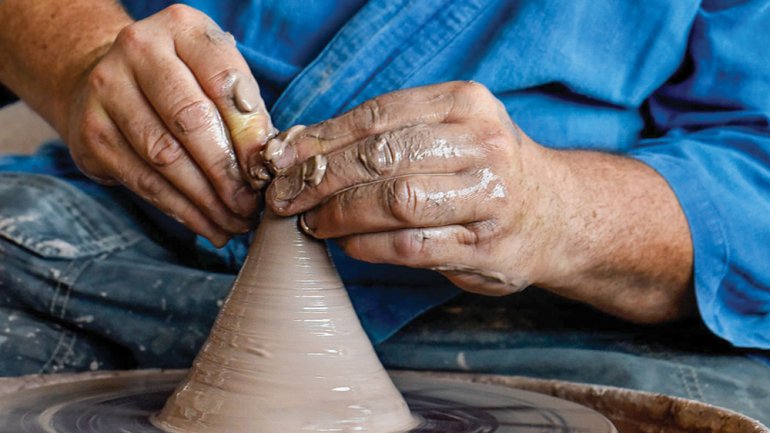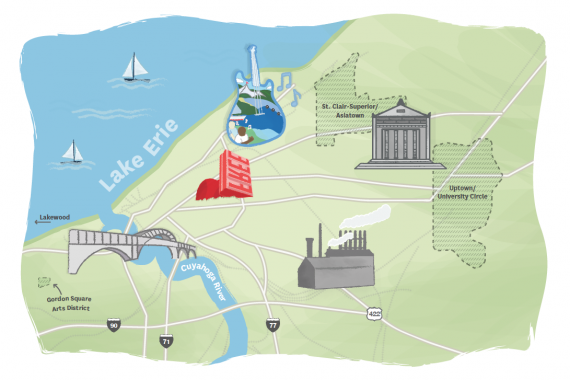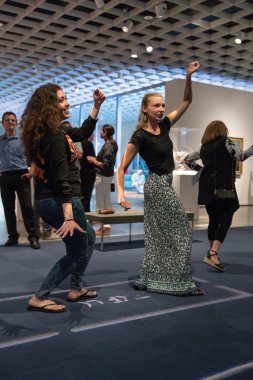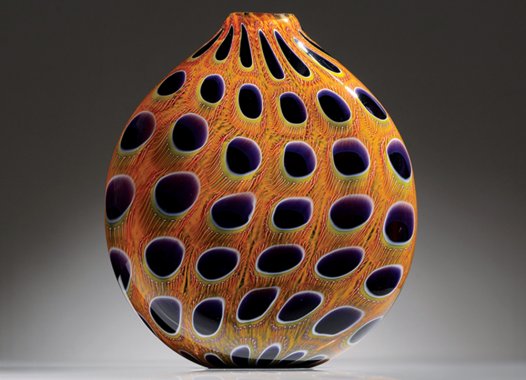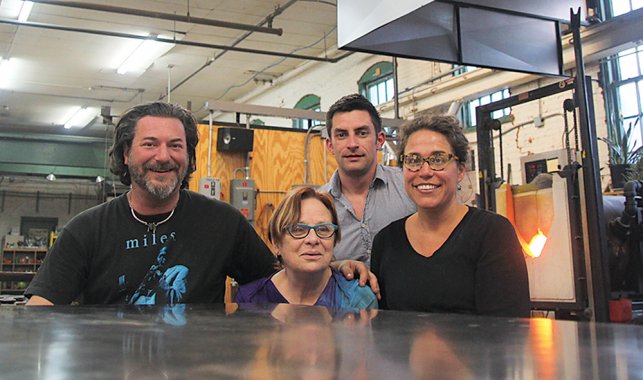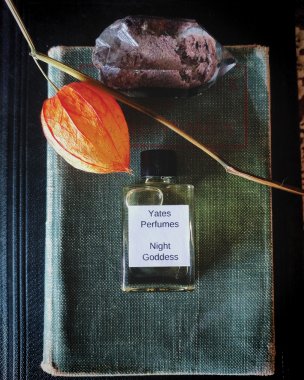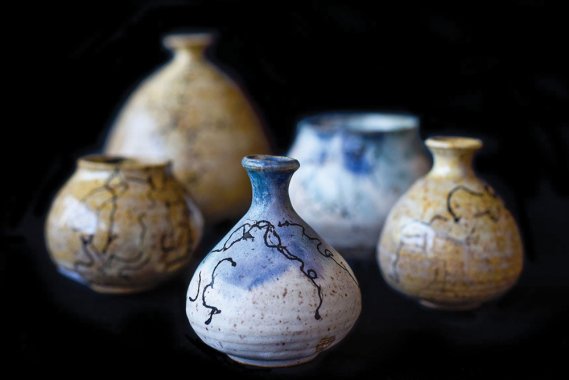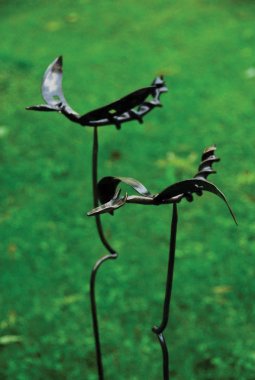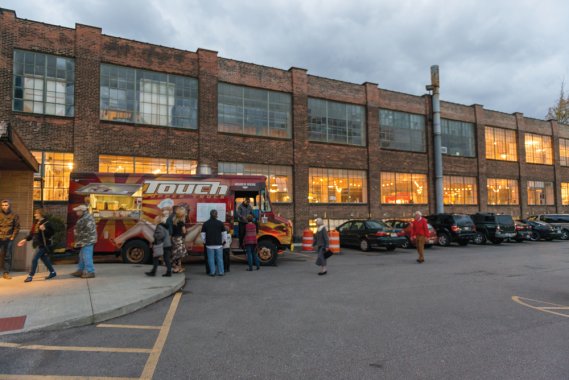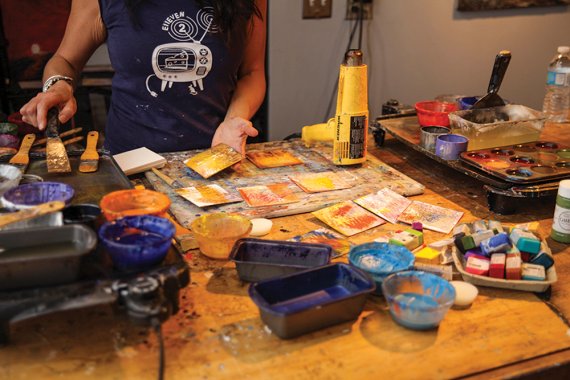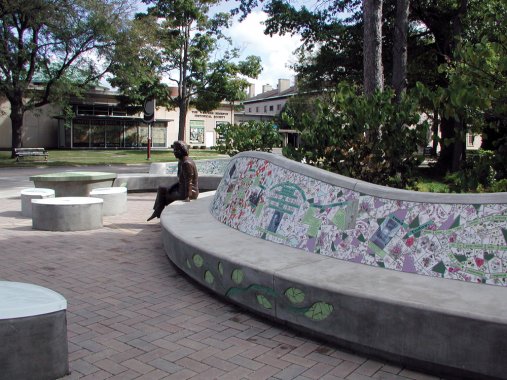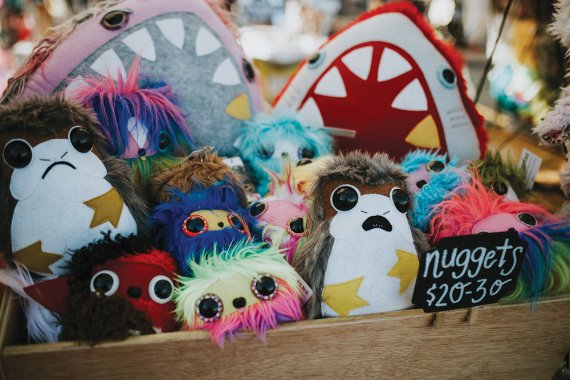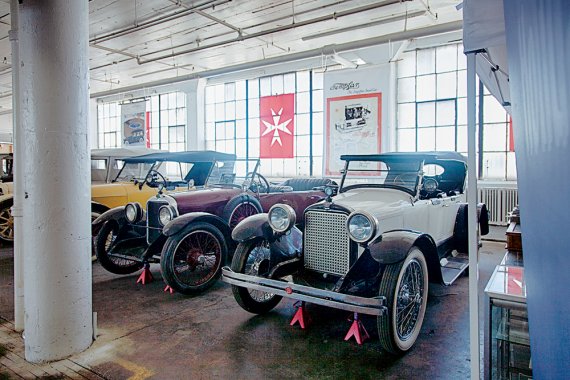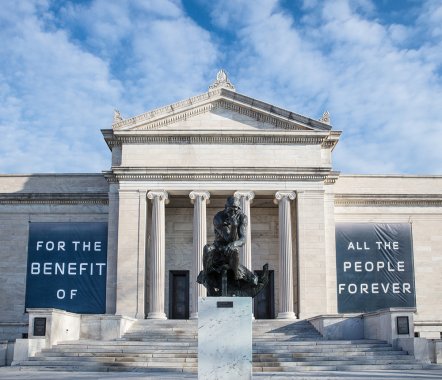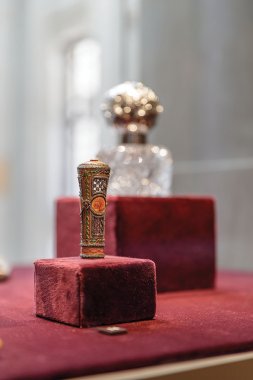The Gears Are Turning
The Gears Are Turning
Just east of downtown Cleveland sits a warren of brick buildings, relics of a bygone era. The former Chisholm Steel Shovel Works complex was an enterprise of the Chisholm clan, who are credited with launching the city’s steel industry in the 1850s. At the company’s peak, 8,000 workers produced the pig iron and Bessemer steel that cemented the city’s reputation as a manufacturing powerhouse.
Today, the huge blast furnaces have been replaced with another kind of flame – the kind the artists of the Superior Hot Glass collective use to create ornaments, vessels, installations, and commissions.
“We got this big space and concrete floors,” founder Sue Berry says. “The high ceilings are nice. It works to our advantage.” Member Shayna Roth Pentecost agrees. “There’s not a lot of places that want these big furnaces running over 2,000 degrees all the time.”
The building has other advantages. Pentecost and Berry chuckle over the couple who rented the space for their wedding. “Everyone made a piece of glass in the wedding colors,” Pentecost says.
The complex and others like it are one reason Cleveland’s craft community is booming. The area is full of factories and warehouses, so studio space is ample and affordable. Couple that with a cost of living 11 percent below the national average, as well as stunning geography – the city sits on the shores of Lake Erie – and Cleveland has become a place where artists can work and grow.
“There’s all kinds of inspiration,” Pentecost says. “In 15 minutes, you can be at the lake, in the woods, at the [Cleveland Museum of Art], the galleries, listening to music. Everything is here that you need.”
Across the Cuyahoga River in Lakewood, an inner-ring suburb, the coordinators of the Screw Factory Artists studios echo that sentiment. The collective of roughly 30 artists has made a home in the former factory of Templar Motors, which made luxury cars from 1917 to 1924; a museum dedicated to the cars is in the building, along with various businesses. Screw Factory coordinators Matthew Richards and Melissa Hale say the mix of commerce and studios gives the complex a unique energy. “You’ve got a lot of different things going on, and that’s what makes our building interesting,” says Richards. Hale notes the building hasn’t shed all of its industrial past. “They still make screws downstairs; a moving company is in the back. We’re all kind of nestled together in this little industrial community.”
Hale owns Yates Perfumes & Apothecary, a small-batch perfumery. Her studio is a bright respite, where small bottles of essential oils and signature scents rest on lace-covered tables. Richards, a potter and a blacksmith, works one floor up from Hale. His studio, Ryu no Sakebi (“Call of the Dragon” in Japanese), is devoted to pottery, but a metal dragon he sculpted speaks to his other medium, which he runs as Grindstone Dragon Forge. Through his blacksmithing work, he has developed an interest in the city’s rich industrial history.
The Pennsylvania native got into pottery as a college student studying in Japan, where he lived for several years following graduation. When he decided to move back to the US, he chose Cleveland as his new home after learning about the city from residents visiting Japan. Once there, he got into blacksmithing. “When I moved here I branched out. I tried to mesh and meld [blacksmithing and pottery]. You have that going on here, people trying different mediums and trying to fuse them together.”
Richards and Hale say the Cleveland Institute of Art’s students and teachers help foster a spirit of experimentation that flows through the creative community. The school has emphasized the decorative arts since its establishment in 1882 as a design school for women. It’s one of several cultural institutions – including the Cleveland Museum of Art and the Cleveland Institute of Music – that exemplify how deeply the arts are integrated into the region’s culture.
Angelica Pozo, a ceramist working in sculpture and mosaics, also notes the impact of the CIA but points out that nearby Kent State University and the University of Akron are also important institutions. “You have good influences. There is a good artisan and craft and maker dialogue that’s happening throughout the city,” she says.
A New York City native, Pozo moved to Cleveland in 1984 after earning an MFA at the University of Michigan. She was lured by the city’s affordable housing and studio space, and easy access to materials and supplies. Several years ago, she needed a crucial component for an adobe installation at the governor’s mansion in Columbus. “I remember researching for materials and realizing ‘Oh, there’s a company in Cleveland that makes that stuff. I don’t have to send away,’ ” she says.
Like Richards, she says Cleveland’s historical remnants contribute to its appeal. “It’s not only materials and manufacturers. I think the detritus – materials you can reappropriate – lends itself to a uniqueness.”
Pozo, who has won numerous commissions for public art, is an artist in residence in Cleveland’s Tremont neighborhood, where she lives. She’s working with residents to create tiles illustrating their memories of the neighborhood, which she’ll use to decorate a bench and flower bed designed as a gathering space.
But the story the space will tell transcends its neighborhood. Tremont was once a community of factory workers. It’s changed, just as Cleveland has. But the region’s industrial past now nourishes its artistic flowering, providing soil for its renaissance.
IF YOU GO
Uptown-University Circle
Any tour of Cleveland’s arts scene should start at the Cleveland Museum of Art, a major cultural force in the region. Located in Wade Oval, it’s surrounded by other prominent cultural institutions including the Cleveland Museum of Natural History and Severance Hall, home of the Cleveland Orchestra. From there, walk a few blocks to the Museum of Contemporary Art Cleveland. The 50-year-old museum, which anchors the newly developed neighborhood around University Circle and Case Western Reserve University, features exhibitions and community events. Next, stroll up the hill through Little Italy. The neighborhood is home to several galleries and studios, including Pennello Gallery, a hub for glass, ceramics, and art jewelry.
St. Clair-Superior/Asiatown
A mile or two east of downtown is Superior Hot Glass. The adjacent communities have been among the most diverse in the city, with a mix of Chinese and Slavic residents. Now artists create where factory workers toiled. Register for classes online or email to arrange a tour.
Gordon Square Arts District
This area on Cleveland’s west side is home to 78th Street Studios, which calls itself the “largest art and design complex in Northeast Ohio.” In a past life, it housed the creative department of American Greetings Corp. Now the building’s tenants include performance spaces, art galleries, and artist studios. You can visit galleries during open house hours on Fridays from 11 a.m. to 4 p.m. or come by the Third Friday event, held monthly from 5 to 9 p.m. The evening, one of Cleveland’s most popular happenings, features food, music, open studios, and gallery events. The complex’s Watch It Wednesdays, on the first Wednesday of each month from 5 to 8 p.m., give visitors the chance to see makers in action.
Lakewood
This suburb is so close to Cleveland that visitors might think it’s part of the city. Nestled on its south side is the Screw Factory Artists studios where craft enthusiasts can see artists working in fused glass, jewelry, and ceramics. To arrange studio visits, contact artists directly through the main website. The building once was the Templar car factory. Upstairs, the Templar Motors Factory Display museum gives visitors a look at the luxury cars built there from 1917 to 1924.
Outdoor Festivals and Fairs
The weather in northeast Ohio is famously capricious from November to April, so residents take advantage of summer’s light and warmth. If you’re in the area, make a point of visiting these outdoor events. On the east side of town, stop at The Cleveland Flea. This quirky flea market, which runs monthly from April through October, has a mission to help makers go from hobbyists to brick-and-mortar business owners. A variety of vendors ranging from jewelers to craft brewers makes for a memorable shopping experience.
Across the Cuyahoga River is the Lakewood Arts Festival, held the first weekend of August. The event hosts about 160 creatives including glassmakers, jewelers, fiber artists, and metalworkers, in the heart of downtown.
After Labor Day, visit the Berea Arts Fest, just west of Cleveland. The festival, which features a juried mix of makers and fine artists including local high school and continuing ed students, is worth the drive.
